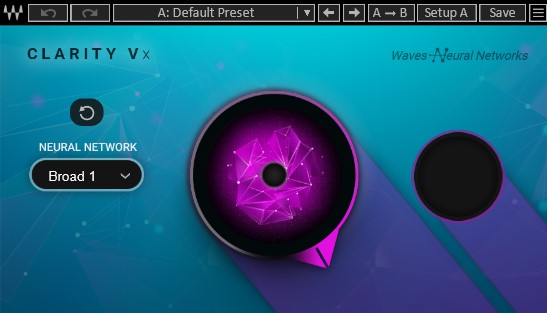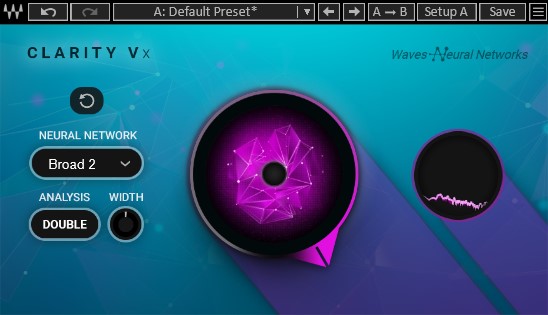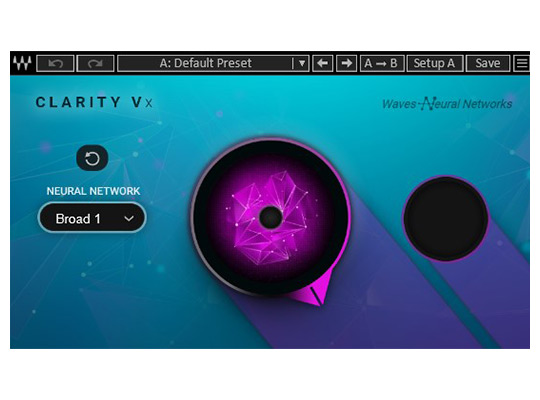With all the talk of AI making our lives easier, one of the main ways in post production is improving our ability to rescue badly recorded audio and Waves Clarity Vx can help. It’s worth saying that anyone in post sound will tell you that by far the most important thing is to get it right on the day – because any fixes that you have to do in post will inevitably degrade the part of the recording that you want to keep. For example where traditional noise reduction will EQ the noise away, it’s impossible that it won’t EQ some of the good stuff away too.
The promise of AI, however, is that it can both remove the offending sounds and add back in the missing parts of the required audio or perhaps remove the bad without removing the good, whichever way you like to think about it. Either way, it’s a great use case for machine learning – sure it’s fairly early days still, so it doesn’t live up to the promise perfectly yet, but it already offers something new to your arsenal.
While there are many, many online tools now that offer this, a lot of us will prefer a VST plugin (or AAX/AU) that we can use to have access to noise removal on the fly in our favourite NLE or DAW, usually a much better workflow than using an online tool. This simple looking tool from Waves is a great option.
Waves Clarity Vx in use
Clarity Vx is one of Waves’ one-knob plugins with very few other options – but don’t be fooled, all the clever stuff is done under the hood and it features the same processing as its bigger and more expensive brother Clarity Vx Pro (more below).
You turn up the dial to remove unwanted background sounds from your dialogue or vocal tracks. You choose the neural network – Broad 1 works for most situations and Broad 2 is useful when there are background voices coming through or more extreme background sounds. Some criticism has been levelled at both of those for being too CPU hungry and Waves recently updated the plugin to include a third lighter neural network called Broad ECO.

Usually dialogue and vocals are mono, but if you have a stereo source, you can use the stereo version of the plugin which gives you a couple more options.

Pricing
It has been permanently on sale as far as I can see since it was released at around $30-40 and at that price I highly recommend it.
Neural Networks
Waves says that Clarity Vx and Vx Pro use neural networks that have been “trained using millions of hours of examples” to help it distinguish between voices and background noise. I think the use of the term “neural network” is stretching things a bit here – usually a neural network may have been used during training, but is then dumbed down into what is still a pretty clever algorithm for the actual tool.
Yet Waves does claim that Clarity Vx “features deep neural networks that are capable of adaptive and continuous processing. As a neural network learns, it accumulates a “history” that influences its future decisions. When playing a region in a loop, the neural network adapts, improving its performance with each pass. This can result in progressively better results with each loop cycle.” Personally I couldn’t see much evidence of this, but it’s worth a try.
Impressive results
In this video Waves run through a few example scenarios and the results are pretty impressive. Yes there are some audible artefacts when a lot of background noise is being removed, but I would say it is far better than most classic EQ based noise removal tools. I’m slightly biased against Waves in general – I don’t love their ecosystem, but I’ve been using it and testing it since it came out last year and it just works really well.
My own testing
I mainly use iZotope plugins and to my mind their Voice De-noise is about the best traditional noise removal tool around. And it comes in the similarly priced RX Elements pack (at least when it’s on sale which is often, including as I write) so I thought a little head to head testing was called for here.
I ran a head to head test of Clarity Vx vs RX Voice De-noise in a few scenarios below. In all these tests I have pushed the processing further than I would in a real mix – it’s often better to have Clarity Vx on 50-75% rather than turning it all the way as I’ve done here. Yes you will have a little background noise coming through, but the artefacts will be less.
In this first test I think both tools do a great job of removing a basic steady hiss which you might get from a cheap pre-amp or cheap mic. This makes sense as this is the easiest noise to remove as it has a constant footprint.
In this second test, neither tool could really deal with the nasty auto-focus lens sounds I introduced, but while both removed the ambience well, I think Clarity Vx did much better to keep the voice tone as is.
Clarity Vx was great with the gravel sounds here, but struggled with the camera handling, but again kept the voice tone much better than iZotope Voice De-noise, which ended up muffling the voice.
I threw a very hard test at it here with background voices and room reverb – what sounds like a barely useable audio recording. Yet Clarity Vx (using the “Broad 2” network this time) did a remarkable job and Voice De-noise unsurprisingly struggled due to the ever changing nature of background chatter.
For test 5 I used the same audio as test 4, but for interest I allowed the use of tools from the much more expensive RX advanced – namely Dialogue De-reverb (which I find much better than the one called just De-reverb) and Dialogue Isolate (which is iZotope’s nearest equivalent of Clarity Vx and also uses machine learning). I liked what Voice De-reverb did to bring the voice closer to the mic and I thought Dialogue Isolate kept the voice a bit closer to the original, but with a bit more chatter coming through. Either way I think it shows that Clarity Vx competes with costlier competition.
Pro Version?
Personally as an editor who does some sound work, I don’t feel any need to have the pro version. As I said above, it uses the same under the hood processing, but does bring a few extra useful features which I think I can live without, like multiband control. But audio mixers might feel differently and it’s worth checking out.
Compatibility
Unfortunately, while it works on almost any DAW, when it comes to NLEs, Clarity Vx is only officially supported for Premiere Pro (though I did find it worked in Resolve as well). I will say though that over the years I have found using 3rd party VST audio plugins within Premiere is one of the main causes of instability and it might well be wise to do your audio editing work in a DAW, which if you’re in Premiere would include Audition which has an efficient roundtrip.
On the Mac side, while it originally ran on Rosetta, Waves have since updated it to be fully Apple silicon compatible which is good news. Plus the fact that Waves can update the neural networks is a good sign for the future that hopefully means it will only get better.


